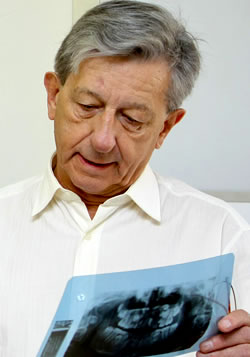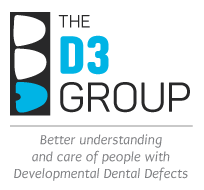D3G SPECIALISTS GUIDE FOR MANAGING MOLAR HYPOMIN
Specialist Stuff
Again building on the Basic Guidelines,here we aim to define the key "shades-of-grey" questions, as may be asked by experienced GPs and paediatric dental specialists, and as could be used in experimental design by researchers. As a starting point, please consider existing guidelines (summaries below) before proceeding to rethink the issues through in a research-friendly way.
Existing Management & Treatment Guidelines from around the world
D3G Australia
- Louise Messer, Melbourne (William 2006) (download figure)
USA
- Tim Wright, North Carolina (Mathu-Muju 2006) (download figure)
Europe
- Nick Lygidakis, Athens (Lygidakis 2010a) (download figure)
- EAPD consensus 2010 (Lygidakis 2010b) (download figure)
- Systematic review 2016 (Elhennawy 2016)
- Würzburg working group 2017 (Steffen 2017, Bekes 2023)
International
- IAPD consensus 2020 (IAPD 2020)
FAQS
A. Diagnosis and treatment planning for Molar Hypomin
Q A1: Severe case – extract or restore?
Subquestions:
- how many dodgy teeth are candidates for extraction?
- caries? – how advanced, pulpal involvement, endo prospects?
- how restorable? – how long will it last, and then what?
- oral hygiene? – secondary caries, and then what?
- pain? – will restoration/desensitisation provide adequate relief, and for how long?
- malocclusion? – will extraction help or hinder, other ortho aspects?
- cost, compliance and other considerations at patient level?
Additional key literature:
- treatment outcomes – Mejare 2005, Jalevik 2011
- see orthodontic aspects
Research needs:
- restorative questions
- orthodontic questions
- individual cost and population economics questions
Q A2: Moderate case – preventive repair or restore?
Subquestions:
- will a preventive approach work long-term?
- what variables are key? – lesion number/size/location, pain, caries risk, patient compliance...?
- restore proactively? – any benefit to getting in early, before it turns to custard?
Additional key literature:
- ??
Research needs:
- how well can moderate lesions be stopped from progressing in the long term?
B. Prevention and pain control
Q B1: Mild & moderate cases – what's the best way to stop progression?
Subquestions:
- can we reasonably expect to maintain or mineralise a Hypomin lesion? – mild?, moderate?
- what approaches work best for remedial mineralisation* ("rem-min") of Hypomin enamel?
- when best to use fluoride? – how best to use, which formulation?
- when best to use CPP-ACP? – how best to use, when to use plus-fluoride formulation?
- when best to use resin? – how best to use, which formulation & protocol?
- when best to use GIC? – how best to use, which formulation & protocol?
- are mild cases (intact surface layer) a different proposition than moderate cases?
- should an intact surface layer be removed?
- should protein removal be attempted? – does hypochlorite approach work?
- does technique for resin infiltration of caries work on Hypomin enamel?
Additional key literature:
- hypochlorite pretreatment of AI enamel – Venezie 1994, Saroglu 2006
- hypochlorite pretreatment of Hypomin enamel – Mathu-Muju 2006, Gandhi 2012
Research needs:
- all of the above questions will benefit from more basic research and clinical trials
[* Important Note:]
Remember that, whereas "remineralisation" is properly coupled with caries-related "demineralisation", it is inappropriate to use this term in context of Hypomin because mineral deficiency exists from the outset. In other words, current understanding dictates that mineral-based repair of a Hypomin lesion is a different proposition than for caries. And with practice, "Rem-min" can be said just as easily as "Remin".
Q B2: What works best for pain control (desensitisation)?
Subquestions:
- is there anything distinctive about treating Molar Hypomin-associated pain?
- special considerations for mild cases? – is it due to invisible porosity?
- special considerations for moderate/severe cases?
- what's best to use and when? – fluorides, CPP-ACP, resin, GIC (as for Q B1)
Additional key literature:
- links between Hypomin porosity & pulpitis – Rodd 2007a, Rodd 2007b
- efficacy of silver fluorides – Maclean 2018
Research needs:
- why the apparent disconnect between painfulness & lesion severity? – is porosity key?
- what desensitising treatments work best for painful mild and moderate cases?
C. Restoration and follow-up
Q C1: How far does the Hypomin lesion actually extend?
Subquestions:
- does the visible Hypomin lesion strictly match the extent of affected surface enamel?
- does the invisible sub-surface lesion always match the surface lesion? – any tortuosity?
- acid-etching issues with Hypomin teeth? – visibly affected & unaffected regions
- so how far should margins be extended? – for bonding?, for filling?
Additional key literature:
- transition between Hypomin & "normal" enamel – Mahoney 2004, Chan 2010, Perez 2020
- acid-etching properties of Hypomin enamel – Mahoney 2004, William 2006
Research needs:
- is visibly-unaffected enamel in a Hypomin tooth clinically normal (cf. restorability, wear)?
- robust criteria for determining the extent of clinically-abnormal enamel
Q C2: Which restorative approach is best for Molar Hypomin?
Subquestions:
- when best to use GIC? – cf. adhesion, wear, pain control
- when best to use CR? – cf. adhesion, wear, pain control
- when best to use SSC? – cf. retention, wear, pain control
- when best to use onlays or the like? – evidence base, for/against?
- any indications for amalgam? – evidence base, for/against?
Additional key literature:
- ??
Research needs:
- clinical trials, comparing the favoured restorative options for common case scenarios
- are "normal restoratives" (optimised for normal enamel) also ideal for Hypomin enamel?
Q C3: How best to use GIC on Hypomin teeth?
Subquestions:
- any particular considerations for GIC in Molar Hypomin context? – surface preparation?
- is there a preferred type of GIC for Hypomin cases?
Additional key literature:
- Use of orthodontic band to improve GIC durability in Hypomin molars – Orellana, 2017
Research needs:
- adhesion properties – Hypomin vs unaffected/normal enamel, product type A vs type B
- wear properties – Hypomin vs unaffected/normal enamel, product type A vs type B
- pain control
Q C4: How best to use CR on Hypomin teeth?
Subquestions:
- any particular considerations for CR in Molar Hypomin context?
- is there a preferred type of CR for Hypomin cases?
- need for pretreatment of Hypomin enamel?
Additional key literature:
- • ??
Research needs:
- adhesion, wear and pain control, as for GIC
Q C5: How best to use SSC on Hypomin teeth?
Subquestions:
- any particular considerations for SSC in Molar Hypomin context?
Additional key literature:
- ??
Research needs:
- efficacy of SSC vs alternatives in different case types
Q C6: What surgical analgesia approach works best?
Subquestions:
- in Molar Hypomin context, are all Hypomin teeth "hard to numb" with LA?
- any links to severity (Hypomin/caries) or sensitivity?
- can hard-to-numb Hypomin teeth be diagnosed in advance?
- which LA administration technique works best? – is there a preferred LA formulation?
- with Molar Hypomin cases, should GA receive stronger consideration than usual?
Additional key literature:
- adjuncts for LA of Hypomin teeth – Discepolo 2011
Research needs:
- diagnostic clues for hard-to-anaesthetise Hypomin teeth
Current D3G Research

Clinical research
As apparent from the FAQs, numerous research questions remain about the most appropriate management of Molar Hypomin, both at preventive and restorative levels. And clearly, such research will be done best using consistent criteria and terminologies for diagnosis, grading and treatment. The D3G network could play a valuable role in coordinating such studies globally.
Basic and applied science
Many opportunities exist for suitably-targeted research to spur the refinement of dental materials (i.e. customised to deal with the vagaries of abnormal enamel better), develop new approaches for dealing with porous enamel, and produce novel diagnostics that facilitate treatment decisions.
Current projects at D3G
Ongoing D3G studies with a treatment focus include:
- resin infiltration of Hypomin enamel – Manton/Crombie/Palamara team
- remedial mineralisation of Hypomin enamel – Manton/Crombie/Palamara team
- biophysical parameters for distinguishing Hypomin enamel – Manton/Palamara team
- molecular diagnostics for profiling and delineating Hypomin enamel – Hubbard/D3G team

